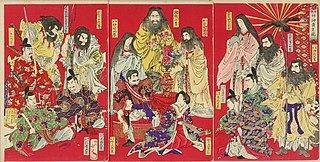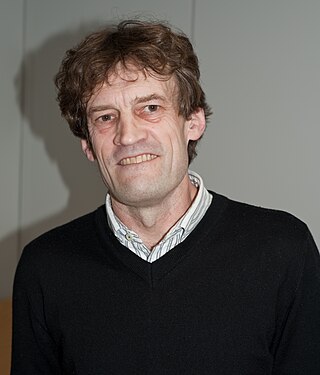
Religion in Japan is manifested primarily in Shinto and in Buddhism, the two main faiths, which Japanese people often practice simultaneously. According to estimates, as many as 80% of the populace follow Shinto rituals to some degree, worshiping ancestors and spirits at domestic altars and public shrines. An almost equally high number is reported as Buddhist. Syncretic combinations of both, known generally as shinbutsu-shūgō, are common; they represented Japan's dominant religion before the rise of State Shinto in the 19th century.
Vernal Equinox Day is a public holiday in Japan that occurs on the date of the Northward equinox in Japan Standard Time, usually March 20 or 21. The date of the holiday is not officially declared until February of the previous year, due to the need for recent astronomical measurements.

Yasukuni Shrine is a Shinto shrine located in Chiyoda, Tokyo. It was founded by Emperor Meiji in June 1869 and commemorates those who died in service of Japan, from the Boshin War of 1868–1869, to the two Sino-Japanese Wars, 1894–1895 and 1937–1945 respectively, and the First Indochina War of 1946–1954, including war criminals. The shrine's purpose has been expanded over the years to include those who died in the wars involving Japan spanning from the entire Meiji and Taishō periods, and the earlier part of the Shōwa period.

Japanese nationalism is a form of nationalism that asserts the belief that the Japanese are a monolithic nation with a single immutable culture, and promotes the cultural unity of the Japanese. Over the last two centuries, it has encompassed a broad range of ideas and sentiments which have been harbored by the Japanese people in relation to their native country, its cultural nature, its political system, and its historical destiny. It is useful to distinguish Japanese cultural nationalism from political or state nationalism, since many forms of cultural nationalism, such as those which are associated with folkloric studies, have been hostile to state-fostered nationalism.

A Shinto shrine is a structure whose main purpose is to house ("enshrine") one or more kami, the deities of the Shinto religion.

The Japanese term shinbutsu bunri (神仏分離) indicates the separation of Shinto from Buddhism, introduced after the Meiji Restoration which separated Shinto kami from buddhas, and also Buddhist temples from Shinto shrines, which were originally amalgamated. It is a yojijukugo phrase.

There have been several controversies regarding the role and the status of the Emperor of Japan. This is due in part to the variety of roles the Emperor has historically filled, as well as the competition for power with other parts of Japanese society at several points in history.

State Shintō was Imperial Japan's ideological use of the Japanese folk religion and traditions of Shinto. The state exercised control of shrine finances and training regimes for priests to strongly encourage Shinto practices that emphasized the Emperor as a divine being.
The Japanese word mitama refers to the spirit of a kami or the soul of a dead person. It is composed of two characters, the first of which, mi, is simply an honorific. The second, tama (魂・霊) means "spirit". The character pair 神霊, also read mitama, is used exclusively to refer to a kami's spirit. Significantly, the term mitamashiro is a synonym of shintai, the object which in a Shinto shrine houses the enshrined kami.
Shrine Shinto is a form of the Shinto religion. It has two main varieties: State Shinto, a pre-World War II variant, and another centered on Shinto shrines after World War II, in which ritual rites are the center of belief, conducted by an organization of clergy.

The Association of Shinto Shrines is a religious administrative organisation that oversees about 80,000 Shinto shrines in Japan. These shrines take the Ise Grand Shrine as the foundation of their belief. It is the largest Shrine Shinto organization in existence.

The controversies surrounding Yasukuni Shrine are related to the choice of Japanese people to visit this Shinto shrine and war museum in central Tokyo. The shrine is based on State Shinto, as opposed to traditional Japanese Shinto, and has a close history with Statism in Shōwa Japan. Most of the dead served the Emperors of Japan during wars from 1867 to 1951 but they also include civilians in service and government officials. It is the belief of Shinto that Yasukuni enshrines the actual souls of the dead, known as kami in Japanese. The kami are honoured through liturgical texts and ritual incantations known as Norito.

The modern system of ranked Shinto shrines was an organizational aspect of the establishment of Japanese State Shinto. This system classified Shinto shrines as either official government shrines or "other" shrines. The official shrines were divided into
- Imperial shrines (kampeisha), which are parsed into minor, medium, or major sub-categories; and
- National shrines (kokuheisha), which are similarly categorized as minor, medium, or major.

A Gokoku Shrine is a shrine dedicated to the spirit of those who died for the nation. They were renamed from Shōkonsha (招魂社) in 1939. Before World War II, they were under the jurisdiction of the Ministry of the Interior, but after World War II they are administered by an independent religious corporation. Designated Gokoku Shrines were built in prefectures except Tokyo and Kanagawa Prefecture. The main deities are war dead from the prefecture or those who are related to them, as well as self-defense officers, police officers, firefighters, and others killed in the line of duty.

John Lawrence Breen is a British academic and Japanologist. He is a specialist in Japanese history at the International Research Center for Japanese Studies in Kyoto. He writes in English and Japanese on the history of Shinto and the imperial institution.

The origins of Shinto in Korea are primarily a result of Japan's incursions since an unbalanced treaty in 1876. Shinto's rise in Korea is directly associated with the Japanese government's ideological use of the traditional folk practices of Japan, later described as "State Shinto." As Japan expanded its control of Korea, it also expanded the number of shrines, with the aim of one national shrine in each province. Before 1945, attendance at shrines was in many cases compulsory.
Lèse-majesté in Japan was a special crime of defamation concerning the imperial family that was in effect between 1877 and 1947, mostly in militarized Japan. It is an act of disrespect against the imperial family and affiliated sites like imperial shrines and mausoleums. It first appeared in 1877 in the draft of the Japanese Penal Code. Later, it was stipulated in Articles 74 and 76 as one of the elements of the current Penal Code, Part II, Chapter 1, "Crimes against the Imperial Family," which came into effect in 1908. Here, the scope of the crime was extremely wide and any actions considered the act to be disrespectful was enacted. Therefore, this law forced Japanese people to support the Emperor, Shinto, and militaristic Japan during World War II. However, after World War II, in accordance with the strong instructions of the Supreme Commander of the Allied Powers, MacArthur, and the spirit of the new constitution, which respects the equality of individuals, "crimes against the imperial family," including lèse-majesté, were abolished in the 1947 revision of the penal code. Therefore, there is no lèse-majesté in the current law in Japan. During the Meiji and Taisho periods, the number of people who were suspected of lèse-majesté averaged less than ten per year, but during World War II, the number increased dramatically, and from 1941 to 1943, the annual average number rose to nearly 160.
Shinto is a religion native to Japan with a centuries'-long history tied to various influences in origin.
Sect Shinto refers to several independent organized Shinto groups that were excluded by law in 1882 from government-run State Shinto. These independent groups have more developed belief systems than mainstream Shrine Shinto, which focuses more on rituals. Many such groups are organized into the Kyōha Shintō Rengōkai. Before World War II, Sect Shinto consisted of 13 denominations, which were referred to as the 13 Shinto schools. Since then, there have been additions and withdrawals of membership.
The Institute of Divinities is one of the former state agencies of Japan. Ministry of the Interior's foreign bureau. Its purpose was to increase the prestige of Shintoism among the people and it was the core of shrine administration and Shintoism until the end of WWII.











